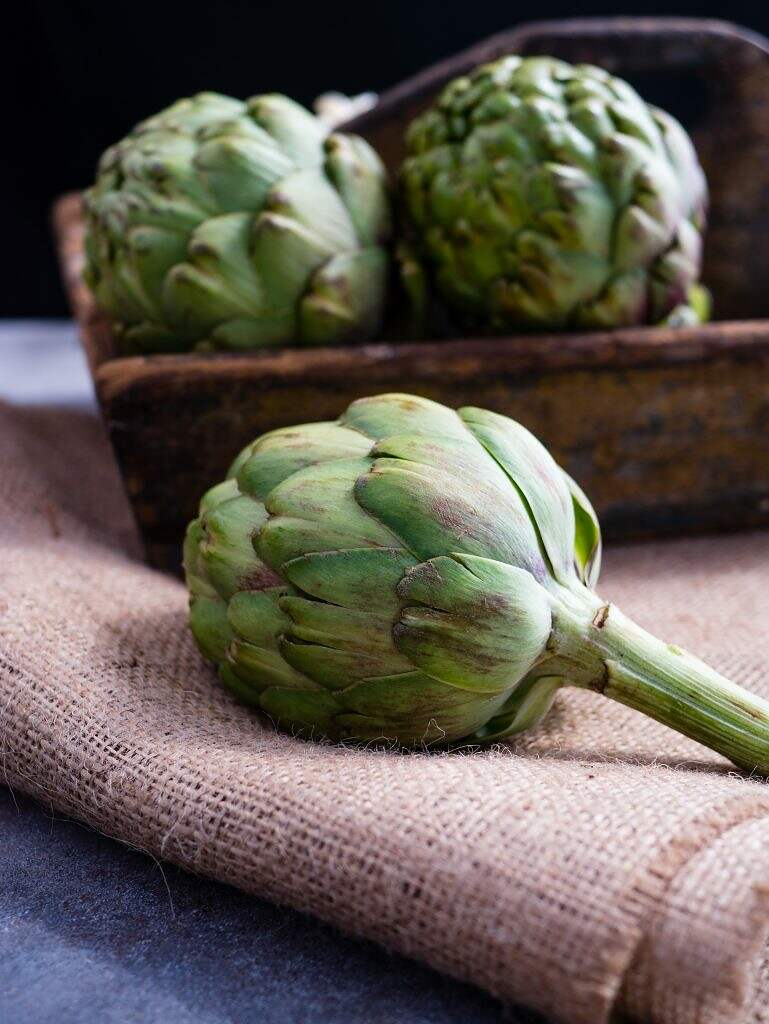Plant Facts
ARTICHOKE – Cynara cardunculus L.
Common Name – Artichoke, globe artichoke
Parts Used – Leaf, immature inflorescence (also referred to as flower “bud” or “head”)
Geographic Distribution – Artichoke is widely cultivated throughout the world. The largest commercial growers are located in France, Spain, Italy, and the United States.
Botanical Description – Artichoke plants can grow up to 6 feet tall with a basal rosette of long, deeply lobed, jagged leaves tipped with yellow spines.

What else do you need to know about an artichoke?
Did you know that artichokes are a type of thistle? Yeah, that’s right. Those pretty purple prickly leaves put this plant in the thistle family. It’s a perennial thistle that is cultivated for its edible immature flower buds. Most people believe them to be a vegetable. This lovely plant is alleged to have many health benefits. This includes: lower blood sugar levels and improved digestion, heart health, and liver health. Artichokes contain lots of nutrients and high concentrations of compounds found in the plant. It is also increasingly popular as a supplement. But, not many people know of its full potential, so allow us to break it down and share all the goodness of this plant.
How can you consume this plant?
Artichoke leaf extract is made from artichokes. This plant is part of the daisy family, and it is native to southern Europe and northern Africa. The leaf, stem, and root are used to make extracts which are used as medicine. The artichoke itself is the bud of a flower. It has leaves that protect the meaty core, known as the artichoke heart. Commonly, artichokes are consumed as food.
What are the benefits of artichokes?
It contains chemicals that can reduce nausea and vomiting, spasms, and gas. These chemicals have also been shown to lower cholesterol and protect the liver. The heart is what people eat. It pairs well with many dishes, from soups to salads.
Artichoke leaves traditionally were used to treat jaundice, acid reflux, some liver disorders, and more. On top of that, research shows that artichoke may be helpful for lowering cholesterol.
People commonly use artichoke for indigestion and high levels of cholesterol or other fats in the blood. It is also used for high blood pressure, hepatitis C, irritable bowel syndrome (IBS), and many other conditions, but there is no good scientific evidence to support most of these uses.
How it can help.
- Indigestion (dyspepsia). Taking artichoke extract by mouth can reduce symptoms of indigestion, including nausea, vomiting, gas, and stomach pain. It seems to take 2 to 8 weeks of treatment to see these benefits.
- High levels of cholesterol and other fats (lipids) in the blood (hyperlipidemia). Taking artichoke extract by mouth can slightly reduce total and low-density lipoprotein (LDL or “bad”) cholesterol in people with high cholesterol. It seems to take 6 to 12 weeks of treatment to see these benefits.
- In one randomized control trial, adults with non-alcoholic fatty liver disease who received 600 mg of Cynara leaf extract daily for 2 months experienced significantly reduced levels of serum liver enzymes and a significant reduction in overall liver size by ultrasound compared to placebo
Preparing and cooking
Artichokes are not as intimidating as it seems when it comes to preparation and cooking. They can be steamed, boiled, grilled, roasted, or sautéed. You can also prepare them stuffed or breaded, adding spices and other seasonings for an extra burst of flavor.
Steaming is the most popular cooking method and usually takes 20–40 minutes, depending on the size. Alternatively, you can bake artichokes for 40 minutes at 350°F (177°C). Keep in mind that both the leaves and the heart can be eaten. Once cooked, the outer leaves can be pulled off and dipped in sauce, such as aioli or herb butter. Simply remove the edible flesh from the leaves by pulling them through your teeth. Once the leaves are removed, carefully spoon out the fuzzy substance called the choke until you reach the heart. You can then scoop out the heart to eat alone or atop pizza or salad.
Adult Dosages
Infusion:1.5-3 g dried leaves as an herbal tea 1-4 times per day, maximum 6 g per day
Tincture: 1.5 – 3 mL (1:5 in 40%) 3x per day
Safety of Artichoke
Artichoke head has Generally Recognized As Safe (GRAS) status in the United States when consumed orally in amounts commonly found in foods.
Pregnancy and breast-feeding: There isn’t enough reliable information to know if artichoke is safe to use as a medicine when pregnant or breast-feeding. Stay on the safe side and stick to food amounts.
Bile duct obstruction: Artichoke might worsen this condition. If you have this condition, don’t use artichoke before talking with your healthcare provider.
Allergy to ragweed and related plants: Artichoke may cause an allergic reaction in people who are sensitive to the Asteraceae/Compositae family. Members of this family include ragweed, chrysanthemums, marigolds, daisies, and many others. If you have allergies, be sure to check with your healthcare provider before taking artichoke.
Gallstones: Artichoke might make gallstones worse by increasing bile flow.
What can you find in our store with this powerful plant?
We carry the tincture form of for easy consumption and daily use.
Stay connected with nature! Join us on the journey to healthy living.
Instagram: https://www.instagram.com/nexttonaturehealth/
Facebook: https://www.facebook.com/nexttonaturehealth
Online Shop: https://www.shopnexttonature.com/
More herbal education for you?
Sources:
Panahi et al., 2018
Substances Generally Recognized As Safe, 2019
Herbarium The Herbal Academy
Webmd
Verywell
Healthline
